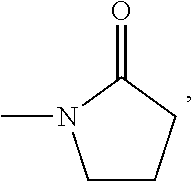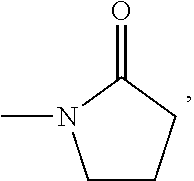Microporous polymer membrane modified by aqueous polymer, manufacturing method and use thereof
a microporous polymer and polymer technology, applied in the direction of plasma technology, nuclear engineering, railway components, etc., can solve the problems of poor compatibility of polyolefin with electrolyte solution (polar organic solvent), poor liquid, and increase of battery polarization, so as to improve battery safety, improve battery performance, and reduce thermal shrinkage
- Summary
- Abstract
- Description
- Claims
- Application Information
AI Technical Summary
Benefits of technology
Problems solved by technology
Method used
Image
Examples
example 1
Preparation of the Microporous Polyolefin Membrane Modified by an Aqueous Polymer of the Invention
[0068]a) Preparation of Polymeric Colloid Emulsion
[0069]Lipophilic monomers styrene (St) / butyl acrylate (BA) / acrylonitrile (AN) were added to aqueous periston solution for ternary copolymerization in an aqueous phase. The copolymer composition was PVP:St:BA:AN=10:2:4:2 (by weight; the same below) and the copolymer content is 15%.
[0070]The polymer emulsion was prepared by the following steps: 1000 g distilled water was added to a four-mouth reaction vessel with condensate water. Then 100 g periston was added to the reaction vessel, and the reaction vessel was heated to 90□ under stirring. When the material was transparent, 20 g styrene (St) monomer and 2 g ammonium persulfate initiator were added. After reacting for 20 h, the mixture changed into a white emulsion. Then, 40 g butyl acrylate (BA) was added. After reacting for 2 h, 20 g acrylonitrile monomer and 1.5 g initiator were added t...
example 2
Preparation of the Microporous Polyolefin Membrane Modified by an Aqueous Polymer of the Invention
[0080]a) Preparation of Polymeric Colloid Emulsion
[0081]In this example, hydrophilic high molecular polyvinyl alcohol (PVA) 1750 and lipophilic monomers vinyl acetate (VAc) / ethyl acrylate (EA) / acrylonitrile (AN) were graft copolymerized in an aqueous phase to prepare an aqueous polymeric colloid emulsion used for a lithium battery membrane; the copolymer composition was PVA:VAc:EA:AN=10:2:2:5 (by weight, the same below), copolymer content was 17% and a product obtained was a white opaque emulsion.
[0082]A specific preparation method of the polymeric colloid emulsion comprised the following steps: 1000 g distilled water and 100 g polyvinyl alcohol (PVA) 1750 were added to a four-mouth reaction vessel with condensate water, and the reaction vessel was heated to 75° C. while stirring at a speed of 100 rpm; and 3 h later dissolution was considered completed when a material obtained was trans...
example 3
Preparation of the Microporous Polyolefin Membrane Modified by Aqueous Polymer of the Invention
[0091]a) Preparation of Polymeric Colloid Emulsion
[0092]In this example, polyvinyl alcohol 1799 (PVA) and hydrophobic monomers ethenyltriethyloxysilane coupling agent (151) / acrylonitrile (AN) were graft polymerized in an aqueous phase to prepare aqueous polymer emulsion, and the copolymer composition was PVA:(151):AN=10:4:5 (by weight).
[0093]A specific preparation method of the polymeric colloid emulsion comprised the following steps: 1000 g distilled water and 100 g hydrophilic monomer polyvinyl alcohol (PVA) 1799 were added to a four-mouth reaction vessel with condensate water, and the reaction vessel was heated to 90° C. until a material obtained was transparent, 40 g ethenyltriethyloxysilane 151, 50 g acrylonitrile (AN) and 1.9 g peroxysulfuric acid initiator were added thereto for 12 h graft copolymerization to obtain the polymeric colloid emulsion.
[0094]b) Preparation of Polymeric Co...
PUM
| Property | Measurement | Unit |
|---|---|---|
| temperature | aaaaa | aaaaa |
| thick | aaaaa | aaaaa |
| temperature | aaaaa | aaaaa |
Abstract
Description
Claims
Application Information
 Login to View More
Login to View More - R&D
- Intellectual Property
- Life Sciences
- Materials
- Tech Scout
- Unparalleled Data Quality
- Higher Quality Content
- 60% Fewer Hallucinations
Browse by: Latest US Patents, China's latest patents, Technical Efficacy Thesaurus, Application Domain, Technology Topic, Popular Technical Reports.
© 2025 PatSnap. All rights reserved.Legal|Privacy policy|Modern Slavery Act Transparency Statement|Sitemap|About US| Contact US: help@patsnap.com



